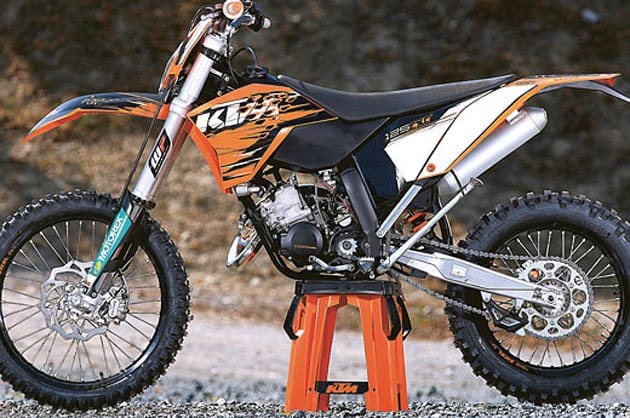KTM Two the Four in 2010
By TMX Archives on 1st Oct 09

KTM is the established front runner when it comes to producing competitive out and out Enduro machines and with a full line-up of both two-stroke and four-stroke orange hardware once again, the Austrian factory stands as strong as ever as we head towards 2010...
When it comes to product development KTM has never really made changes just for the sake of making changes. The Austrian manufacturer has tended to generally leave things alone during the 'no new model' years. So for the 2010 model year, KTM has, with a few exceptions, left its eight-bike EXC enduro range virtually unchanged. Which is certainly no bad thing.
I say virtually unchanged because there have been some, albeit small changes and updates. With all but the 200 and 250cc EXC models receiving some tweaks, KTM has ensured its orange army of enduro weaponry remains the most complete range offered by any manufacturer.Even to the trained eye KTM's 2010 offerings look little different to their 2009 predecessors. With most of the limited number of setting tweaks, adjustments and refinements taking place within the motor, externally the bikes look little different to those which have been available in 2009.
That fact that KTM once again offers the most complete range of any manufacturer isn't to be overlooked. With no new models stealing the limelight the complete range, from 125cc two-stroke to Enduro 3 class four-stroke, stands proud. And so it should! With all models successful at the highest level as well as popular with the buying public, KTM sees no reason to change a winning formula.
CHANGES
Changes made to the two-stroke EXC range are few.
The 125cc two-stroke, without question one of the best performing bikes in its class, has pretty much been left well alone. In saying that, in the motor first gear has been strengthened and the exhaust is now made from a single steel skin to improve performance. The chassis has been tweaked with a half-degree steeper steering head angle as well as new triple clamps, which offer quicker steering.
The 250 and 300 EXC machines both receive reinforced cylinder heads, which KTM claims improves durability, as well as single-skin exhausts. The 300 also gets an improved starter gear for the fantastic electric start system. The chassis for the two biggest two strokes remains unchanged but the suspension settings have been 'revised'.
When it comes to the Austrian marque's three four-stroke bikes, the list of changes is slightly longer. All bikes get a harder piston to ensure longer life. The 250 and 400 have had the de-compressor units worked on to ensure better starting, while the 400, 450 and 530 all feature stronger gear-boxes.
All three of the bigger four-strokes have a newly designed oil ring with the 530 also getting a reworked hydraulic cam chain adjuster and new camshaft timing, to give improved reliability and offer better power output.
But it's in the chassis department where KTM has made the biggest changes to its 400, 450 and 530 EXC models. With the larger percentage of KTM's 450 EXC sales coming from 'hobby' riders and clubmen, KTM has opted to lighten the steering on its three big four-strokes.
All EXC models also get the same Brembo brake systems as used on the 2009 SX models.
CHASSIS
With the exception of the new chassis introduced to the 400, 450 and 530 EXC models, there is little different in the way each of the 125, 200, 250, 300 strokers and 250cc four-stoke ride when compared to the models they're replacing. By no means a bad thing and in all honesty KTM's two-stroke line-up is all but impossible to fault.
But anyone who has owned, or even ridden, any of the bigger four strokes will quickly notice the changes made in the chassis department, particularly taller riders. Claiming that some riders had found the steering a little heavy - I personally never found it anything but well planted and predictable - KTM has addressed the alleged issue and reworked the chassis to lighten the feel of the steering.
What the designers have essentially done is change the point at which the frame attaches to the steering head tube. Keeping the forks in the same place as 2009 they have basically dropped the frame down 10mm before fixing it to the triple clamp tube. This has the effect of lowering the seat and tank area - great for smaller riders. The handlebars on the bikes are also six-millimeters lower than last year.
Six mill doesn't sound a great deal, but it is noticeable. While the lowering of the seat and tank give more room under the bars, the fact that the bars are also lower means that when standing on the pegs the front end feels to be more underneath you rather than in front.
There's no denying that the steering is lighter, which is especially noticeable on slower, more technical terrain. But my initial feeling was that I preferred the steering the way it was, not how it now is. Without fitting higher bars, a different front tyre and setting the bike up a little better, it's impossible to comment accurately on whether the changes are better. The steering is definitely lighter, but I left the launch a little unsure about the front end.
Steering aside I loved the 450 model. Although little has been done to the motor, it felt altogether more enjoyable to ride with a smooth power delivery and a huge amount of usable torque. Having preferred the less powerful 400 model last year, both bikes were hugely enjoyable to ride with the 400 still needing to be ridden hard, whereas the 450 had bags of tractable grunt.
The 530 has changed little but in the hands of an experienced big-bore four-stroke rider, it is very hard to beat. The power is as plentiful as ever, but anything but hard hitting.
IMPRESSED
But it was the 250cc four-stroke that impressed me most. For a long time the E1 class four-stroke against which all others are measured, the 250 EXC-F now has some serious competition in the form of Husqvarna's all-new TE250, but despite it's limited changes, the orange machine still ticks a huge number of boxes.
The one thing that let down the 250cc four-stroke last year was its somewhat mushy suspension. Fine when ridden conservatively, but when pushed hard the forks and shock didn't feel as sporty or as strongly sprung as possibly they could have been. This year the suspension adjustments ensure that the 250F feels altogether more robust, which allows it to be ridden harder.
Pushing the 250F hard isn't the only way that it can be ridden, as the great spread of power again ensures it will appeal to riders of all abilities. However, when the engine is kept revving, the bike comes into its own. Tackling everything that's thrown in its way, KTM's smallest capacity four-stroke is still a bike that's hard to beat.
The on-track performance of all of the EXC two-stroke range was hard to fault. The 'baby' 125 model feels as robust and purposeful as ever, and still delivers some of the best performance of any bike in its class. The 200 model is still the 'odd' bike of the range and is again essentially the same as it has been for a few years. It's a great trail riding machine, but still a little hard to figure out when ridden hard.
The huge numbers of 250 and 300cc EXC machines being used all across Europe is testament to just how good KTM's larger capacity two-strokes are. Both bikes have received basic revisions as, well, they didn't really need changing as there were no notable issues with either machine.
The 250 and 300 are night and day different machines - as they've always been. The 250 is a real racer's bike, while the 300 is simply a joy to ride, with the added benefit of the electric starter. Although the 250 has a great spread of power it is an occasionally aggressive little beast and is better suited to more experienced and competent riders.
The 300 stroker has mass appeal by the bucket-load. Amazingly soft and easy to ride, when pushed harder it becomes a go-anywhere, do anything bike that puts a massive smile on your face. No matter if it's faced with a technical, rock-littered climb or flowing, open grass covered fields, the bike does everything it should - and more. There's no hit to the power, the delivery is smooth and plentiful, and the bike's general track manners are impeccable.
And the electric starter is the cherry on top of a must-have cake...
SPECIFICATIONS
2010 model KTM 125/ 200/ 250/ 300 EXC
ENGINE
Type: Liquid-cooled, single cylinder, 2-stroke with exhaust control TVC
Capacity: 124.8 cc/ 193 cc/ 249 cc/ 293.2 cc
Bore x Stroke: 54 x 54.5 mm/ 64 x 60 mm/ 66.4 x 72 mm/ 72 x 72 mm
Starter: Kickstarter (125/ 200/ 250)/ Kick and electric starter (300)
Transmission: 6 gears (125/ 200)/ 5 gears (250/ 300)
Carburetor: Keihin PWK 36 S AG
Lubrication: Oil/ fuel mixture at 1 : 60 ratio
Final drive: X-ring chain 5/8 x 1/4"
Clutch: Hydraulically operated wet multi-disc
Ignition: Kokusan
CHASSIS
Type: Central double-cradle-type 25CrMo4 steel with aluminium subframe
SUSPENSION
Front: 48 mm WP USD forks
Travel: 300 mm
Rear: WP PDS shock absorber
Travel: 335 mm
BRAKES
Front: 260 mm single disc brake
Rear: 220 mm single disc brake
WHEELS/RIMS
Front: 1.60 x 21" Excel
Rear: 2.15 x 18" Excel
TYRES
Front: 90/90-21"
Rear: 120/90-18" (125/ 200)/ 140/80-18" (250/ 300)
Main silencer: Aluminium
Handlebar: Tapered 28/ 22 mm Neken aluminium
DIMENSIONS
Wheelbase: 1,471 mm ± 10 mm
Ground clearance: 390 mm (125/ 200)/ 385 mm (250/ 300)
Seat height: 985 mm
Fuel capacity: Approx 9.5 litres
Weight (no fuel): Approx 97 kg (125/ 200)/ approx 100.8 kg (250)/ approx 103.1 kg (300)
SPECIFICATIONS
2010 model KTM 250 EXC-F/ 400/ 450/ 530 EXC
ENGINE
Type: Liquid-cooled, single cylinder, 4-stroke with 4-valve DOHC and finger followers (250)/ roller rocker levers (400/ 450/ 530)
Bore x Stroke: 76 x 54.8 mm/ 95 x 55.5 mm/ 95 x 63.4 mm/ 95 x 72 mm
Capacity: 248.6 cc/ 393.4 cc/ 449.3 cc/ 510.4 cc
Compression ratio: 12.8 : 1 (250)/ 11.1 : 1 (400/ 450/ 530)
Starter: Kick and electric starter
Transmission: 6 gears
Carburettor: Keihin FCR MX 39
Lubrication: Pressure lubrication with 2 oil pumps (250)/ with 3 oil pumps (400/ 450/ 530)
Final drive: X-ring 5/8 x 1/4"
Clutch: Wet multi-disc clutch, operated hydraulically
Ignition: Kokusan digital
FRAME
Type: Central double-cradle-type 25CrMo4 steel with aluminium sub-frame
SUSPENSION
Front: 48 mm WP USD forks
Travel: 300 mm
Rear: WP PDS shock absorber
Travel: 335 mm
BRAKES
Front: 260 mm single disc brake
Rear: 220 mm single disc brake
WHEELS/RIMS
Front: 1.60 x 21" Excel
Rear: 2.15 x 18" Excel
TYRES
Front: 90/90-21"
Rear: 120/90-18" (250)/ 140/80-18" (400/ 450/ 530)
Main silencer: Aluminium
Handlebar: Tapered 28/22 mm Neken aluminium
DIMENSIONS
Wheelbase: 1,475 mm ± 10 mm
Ground clearance: 380 mm
Seat height: 985 mm
Fuel capacity: Approx 9.2 litres (250)/ approx 9.5 litres (400/ 450/ 530)
Weight (no fuel): Approx 105.7 kg (250)/ approx 113.9 (400/ 450/ 530)
Specification:
